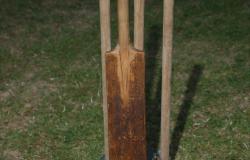Everton Weekes: Cricket, Culture and the Struggle for Change

Brian Stoddart remembers Sir Everton Weekes as a major figure in the struggle for racial equality in sport, as well as one of the great cricketers.
With the passing of Sir Everton DeCourcey Weekes at ninety five, the world lost not only one of its greatest-ever cricketers but also (amidst what in this day and age should be an unnecessary Black Lives Matter campaign) a major figure in the history of sport’s racial equality story.
His cricket record is straightforwardly magnificent. At his death, Everton Weekes still held the tenth highest-ever test match batting average: 48 tests, 4455 runs at an average of 58.61 per innings. In 152 first class matches he scored just over 12,000 runs at an average of 55.34 per innings. And these figures become astonishing when it is recalled they were achieved between the 1940s and the 1960s when pitches were far less protected than now.
But his place-in-history story is even deeper, perhaps even more impressive and, for me, comes with a personal touch.
In the 1955-56 southern hemisphere summer, West Indies completed a full tour of New Zealand. Weekes scored a century in each of his first five innings, another in a later innings, and finished the tour with an average of 104. And that success was embellished by style – he had all the strokes and more, loved to hit the ball, and played with enthusiasm. In New Zealand, where English batting textbooks and etiquette ruled, that was a cricket form we did not know.
But we also saw another rarity, a touring team made up almost entirely of black players. Ironically, a few months later in rugby, the New Zealand All Blacks (with just three Maori players) met the South African Springboks who were all white. Maori players had for years been banned from touring South Africa under apartheid rule, and this was early in the lead up to the boycott movement.
Everton Weekes and his colleagues, then, showed South Africans and New Zealanders alike what was possible.
In particular, Everton won over my father, a cricket fan and New Zealand-level lawn bowler, who took me to see both Christchurch matches, against Canterbury then New Zealand. I had myself started playing by then and wanted to see my New Zealand hero Bert Sutcliffe, who became one of the many batsmen destroyed by the Caribbean spin twins, Alf Valentine and Sonny Ramadhin (the latter among the first Indian-origin players to appear for West Indies, another struggle for equality).
But I left that test match as a Weekes and West Indies fan. In backyard cricket from then on, I “played” for West Indies when all others were for New Zealand or England (none wanted to be identified with Australia!). Selected for advanced coaching, my first mentor was Peter Wight who came from British Guiana, as it was, but played for Somerset in English county cricket. Like Everton, he loved to hit the ball and astonished us all by hitting one out of the Ashburton Oval.
It was about then, too, that I began to “read” cricket in its social sense, the first steps towards becoming a sports historian with an initial interest in how the game became part of the imperial project. After all, how was it that people like Everton and Peter became so good at cricket, played it so differently, came from exotic places but ended up in ones like England and New Zealand (and as I discovered, of course, many others as well).
There was obviously meaning in there somewhere.
So in that direct sense, Everton led me to CLR James and Beyond A Boundary that I read when it first came out – and scarcely understood a word. As time passed, though, it made more sense and cricket emerged from the Jamesian analysis as a lodestone for cultural impact and struggle within the imperialist/colonialist arena.
Everton Weekes, Frank Worrell, Clyde Walcott and all the others, then, for me, broadened from being straightforward cricketing icons into part of what in the Indian history context became identified as the “subaltern” response to the imperialist presence. Here, in the Gramscian and Bourdieusian senses, was the notion of resistance and assertion.
And that eventually led me to Barbados itself, Everton’s home, to both play and research the game as an important aspect of the Barbadian and Caribbean historical story.
One of the most famous sections in James is where he describes the stratification of Trinidadian cricket clubs by an intersection of colour and class: elite white, middle class white, professional brown, respectable black and so on. When James left school, he “knew” which club he needed to approach.
Barbados was the same – many of my friends repeated the James experience when they left school. Having been born poor on a plantation, Everton Weekes might have grown up near Kensington Oval but could never have played for its then-home club, Pickwick. In fact, he could not even play in the same competition as that the club. He began with a team in the Barbados Cricket League, created for people like him who could otherwise never play competitive cricket – this complexity of social layering all occurred on an island of about 250,000 people.
Then, during World War Two, by joining the army, he could play for that team in the elite Barbados Cricket Association competition, that led quickly to his inclusion in Barbados then West Indies teams. Along that storied path, too, he became a stalwart of the Empire club, formed during World War One for lower middle class blacks. He could not have played for them previously.
It is sobering to think that but for this socially complex and fortuitous trajectory, Everton Weekes might never have been seen anywhere in the world, let alone New Zealand. Such was the power of exclusion.
As part of my Barbados project, I had an extended radio interview with the voice of West Indies cricket, Tony Cozier. Afterwards, I asked him for Everton’s phone number because, obviously, after all this time, I just had to speak to the great man.
Here lay the deep-seated and uncomfortable dimensions of the “imperial” game. All those colour and class contours cast long shadows. Everton played his last test match in 1958. It was only in the following year that West Indies was first captained regularly by a non-European. That was Frank Worrell, as the result of a major struggle launched by CLR James from Trinidad where he had returned from the United States following the McCarthy inquisition. Everton then became the first non-white captain of Barbados, at the tail end of an illustrious career.
In all his time until then Everton, and his distinguished friends, played under a white captain. And for most of that time, John Goddard captained both Barbados and West Indies. He came from a traditional and prominent elite Barbados European family, and was a good enough all-rounder – but nowhere near as good as Worrell, Weekes and Walcott, the “3Ws” as they became known. In test matches, Goddard had a batting average of just 30. But he was the leader, because he was white. And to the international “imperial” cricket establishment, he was the natural leader. But from almost the beginning of Everton’s career, that was not the dominant view inside the teams. Dissension and resignations became increasingly common.
Throughout his career, then, Everton suffered all the slights of race and class that could be thrown, not only abroad but also at home. Over several years, for example, he played for Bacup in the Lancashire League, access to county cricket then barred to itinerant players like him. In that, he followed the wonderful Lord Learie Constantine who, with CLR James, had led the way by playing for Nelson in the Lancashire League, then went on to a distinguished career in opposing racial discrimination in cricket, sport and society. Like Constantine, Weekes was popular with most players and crowds, but not all.
All this and more had run deep in places like Barbados so when I asked Tony for that phone number his immediate thought was that Everton might not want to talk to me, an example of the white privilege with which he had needed to deal.
But during the radio chat, Tony had drawn out the story of how I might have played for Wanderers, the traditional elite club, but had chosen instead to play for Maple, the BCA’s newest addition, drawn from the lower status outskirts of Bridgetown.
Tony finally gave me Everton’s phone number.
I called.
“Mr Weekes, I’m a New Zealander but from Australia and I’m researching Barbadian cricket history. I wonder if I might come and talk with you?”
The silence seemed to stretch for ever, then came that marvellous Bajan voice.
“Are you the white man playing for Maple?”
He had heard the interview with “Coze”.
“Yes, Mr Weekes.”
Another pause.
“You can come and talk to me.”
That led to several months of discussion and friendship with great insights and humour. He gave me his views on that tour of New Zealand, and how he found the people and the cricket culture. Then, in the BCA rooms during a test match one pompous official, irritated I had already met almost all the famous players to whom he was “introducing” me, finally pointed at Everton sitting away on his own and suggested I could not possibly know him (because I was white, obviously). I took a couple of drinks over, sat down and Everton, guessing what had happened, greeted me like a long lost friend.
When Alan McGilvray, the great Australian cricket commentator, did his last broadcast, I listened to it in our Barbadian house along with Everton and Tony who both remembered their experiences in Australia while we drank Banks beer.
And when Everton turned up at the house one day in his gleaming BMW, immaculately dressed and gold chained, Sandi remarked that he was looking very well.
“I paid my dues,” came the response.

Sir Everton Weekes (centre) - Public Domain
Indeed he had.
For years, for example, the dominant cricket world had riffed on the idea of “Calypso” cricket as played by Everton & Co being flashy and slapdash, the term often transmuted into “Collapso.” That is to say, it was regarded as an unreliable, irresponsible form of the game that in its imperial and post-imperial realms was supposed to bring discipline and commitment. This despite all that Caribbean cricket had achieved around the world. It was a direct reference to the perceived deficient nature of black culture and social outlook, and it hurt.
That discriminatory trope was laid down by people like Lord Harris, a nineteenth century governor of Bombay as well as an architect of cricket as the imperial shaper. He thought Indians would never be fit to govern themselves until they learned to play the game properly. (If only he could return now). And that approach was perfected by the Imperial Game man himself, Sir Pelham Warner whose Trinidadian forebears had been slave owners. (To be fair, though, Warner was among the first of the Caribbean elite to allow for the inclusion of black players).
Cricket had emerged strongly in the immediate aftermath of abolition and, as James pointed out and the Barbadian situation confirmed, did a great deal to restratify the newly liberated population by way of cultural stationing. That was the origin of those stratified cricket clubs that reinforced all those other social divisions that lasted for so long – the Barbados Yacht Club was said to have lost its “Royal” prefix after the Duke of Edinburgh discovered he could not take the (black) Prime Minister in there.
As the Jamaican-born Harvard sociologist Orlando Patterson put it: cricket “becomes on the symbolic level the English culture we have been forced to love, for it is the only real one we have, but the culture which we must despise for what it has done to us, for what it has made of the hopeless cultural shambles, the incoherent social patchwork, that we have called Afro-Jamaican culture.” Here was the spectacle of black men playing the “white boss’ game in white clothes and according to white rules.
For the century after the formalisation of West Indies cricket, then, with Everton a major contributor, the essential struggle was to establish a new cultural identity for the game.
West Indies astonishing series victory over England in England during 1950 was a major step in that reclamation, with Everton Weekes at its heart. He scored 2310 runs at an average of 79.65, including fives scores of 200 or more including one triple century. His partnership of 283 with Frank Worrell during the third test match was pure quality.
He – and Worrell – demonstrated that players from the non-white Empire had truly arrived and that led the way eventually for India, Pakistan, Sri Lanka, Bangladesh and Zimbabwe to all emerge as cricket powers alongside the “White Dominions” (within which, of course, similar discrimination was rife).
In 1948-49, on his first tour away from home, Weekes had scored 2394 runs including ten centuries in newly independent India, Pakistan and Ceylon. Along with the rest of the team he was received extremely well and later remembered with affection their rousing receptions, as well as the long train journeys. In sports terms, this was among the earliest occasions when the non-white sections of the empire met, a significant stage in the journey towards a postcolonial condition.
That 1950 triumph was signified by Wisden, the cricket “Bible”, naming Weekes and Worrell, along with their spin twins Ramadhin and Valentine, as “Cricketers of the Year.” Until then, just three West Indians - Constantine, George Headley (“Black Bradman” in the white cricket world whereas in West Indies, Bradman was the “White Headley’) and the white Barbadian George Challenor - had been so honoured.
Unlike Constantine and Worrell, though, it is reasonable to suggest that Everton relied on his cricket rather than direct activism to make the point about race. His was a cricket revolution rather than the more socially defiant stance that characterised West Indies’ later period of dominance from the 1980s into the early twenty first century, led by the aggression of Clive Lloyd and Viv Richards through their fast bowlers like Malcolm Marshall, Michael (Whispering Death) Holding, Joel Garner, Curtley Ambrose, Colin Croft and all the rest.
That was all wonderfully captured in the documentary, Fire In Babylon, and emanated in some minds at least from the Rastafarian movement and linked to the rise of reggae, the quintessential statement of Caribbean culture
In the wider context, that was again all part of the anti-racial agenda pioneered by James and Constantine among Caribbean identities, and sat prominently alongside breakthroughs like Jessie Owens in 1936, Jackie Robinson breaking into Major League Baseball, Althea Gibson winning at Wimbledon, Tommy Smith and John Carlos at the 1968 Olympics, Simone Biles and all those other firsts that were and remain so important even if, sadly, we know there is still so much to achieve.
Everton was always a quiet part of that huge story when we sat talking, a bright and contemplative man – he was a brilliant bridge player, for heaven’s sake. Yet that quiet could never disguise the importance of what he had done, a poor black man who became a world figure and, along the way, showed his own people what they could achieve and helped others change their attitudes towards those people.
And when we spoke, some things had not changed. During the last couple of weeks Sandi and I had left in that long Barbadian stay, the cricket official who thought I could not possibly have met Everton told us it was time for us to leave anyway.
“Why is that?”
“Because if you stay, you’d have to choose between them and us.”
Had we stayed, I would have tried to play at least one game for Empire, the team into which Everton had fought his way. I had not thought that remotely possible but, again in those last few days, my friend Charles Alleyne asked me why I had never approached them. It was because I had thought they would never have me.
“Oh, he said, “we’d have taken you, man!”
Everton Weekes had made that possible in so many ways.
For this kid from New Zealand, then, Everton was a master guide to thinking about the “Other”, as Edward Said would later put it. What a magnificent guide he was in style, deed, purpose and impact, as well as being a marvellously warm person.
It was a privilege to have known him.
Image: Andy Rogers via Flickr (CC BY-SA 2.0)


